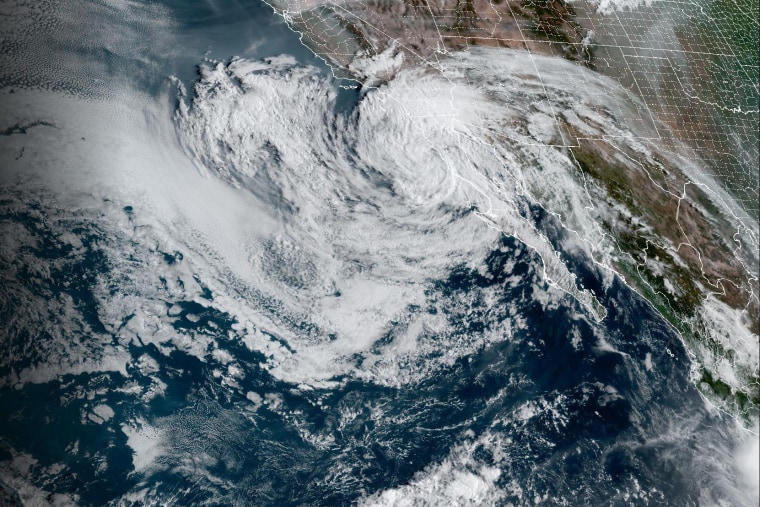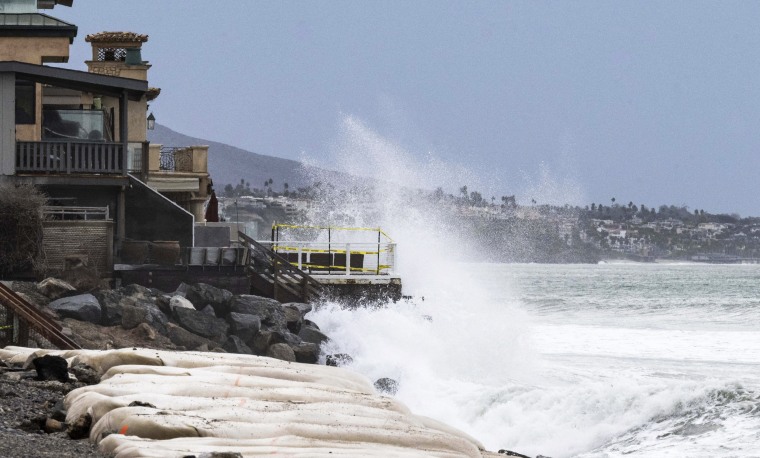Tropical Storm Kay was downgraded to a post-tropical cyclone on Saturday as it weakened and pulled away from Baja California, according to the National Hurricane Center.
As Kay continues to weaken, heavy rainfall and flash flooding, especially over areas with sensitive soils, remain a threat for portions of Southern California, southern Nevada and northwestern Arizona as the storm moves farther into the eastern Pacific over the weekend, meteorologists said.
Up to 2 inches of rain could fall in some areas this weekend, and flood alerts were issued for 8 million people, including residents of Las Vegas and Palm Springs.
Thunder and lightning was reported Saturday in San Luis Obispo County, on the state's Central Coast, the National Weather Service reported.
"These storm cells will likely produce brief heavy downpours, gusty winds, and possible lightning," it tweeted.
Increased cloud cover and moisture from Kay, however, will bring relief from the record-breaking heat that targeted the West for the past two weeks, the National Weather Service said.
Fire activity in California was also reduced due to moisture from post-cyclone Kay.
California's Fairview Fire, which claimed two lives after breaking out southeast of Los Angeles on Monday, was 40% contained as a result of Kay, according to the California Department of Forestry and Fire Protection. The 28,307-acre fire is expected to be fully contained by Monday.

Still, four uncontained fires raged in Southern California on Saturday, and five burned in the northern half of the state, according to the National Interagency Coordination Center.
Outside Sacramento, the Mosquito Fire continues to burn unchecked. It has consumed 33,754 acres since it started Tuesday, according to Cal Fire.
One of its newest wildfires, the three-day-old Barnes Fire in Modoc County, in the northeastern corner of the state, had burned up 5,703 acres by Saturday, and had no containment. Authorities say it was caused by a lightning strike.
There are also "red flag warnings" in place until 11 p.m. Saturday evening for many parts of the Northwest, including Seattle and Tacoma in Washington and Bend and Portland in Oregon. Around 9 million people are currently under extreme fire weather conditions.
According to a tweet from the National Weather Service field office in Portland, there's thick smoke over northwest Oregon and parts of southwest Washington "largely from the Cedar Creek Fire."
Oregon utilities company Pacific Power shut down power to approximately 12,000 customers on Friday to reduce risk of wildfire ignition, they said in a tweet. Overnight wind conditions "materialized and peaked as forecasted" and the agency is now in process of verifying that the system is safe.
"Once patrols are completed, we will begin the process of restoring service to customers," the agency said in a news release on Saturday. "However, if repairs are needed, service restoration could last into the afternoon or evening."
Kay was removed from the National Hurricane Center, which on Saturday reported no tropical cyclones in the Pacific zones it covers.
The weather service's San Diego office reminded residents that, despite the gloomy looks, summer was still here, and still strong. High temperatures in the upper 80s were expected for much of urban Southern California on Monday and Tuesday.


